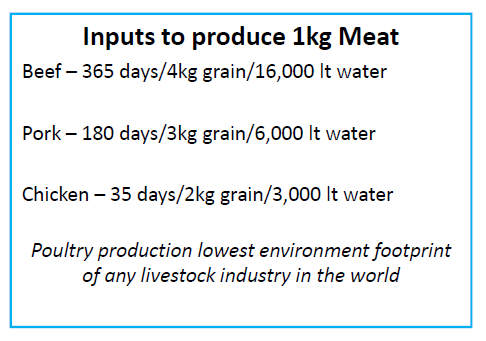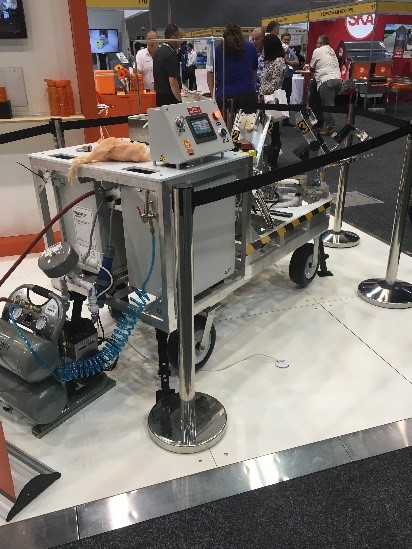Wiley recently attended the 2016 Poultry Information Exchange (PIX) and Australasian Milling Conference (AMC), also known as PIX/AMC 2016 held on the Gold Coast. We share our top insights from the event including:
- Sustainability and competitiveness – producing more from less.
- Bird welfare – Improving bird health and industry transparency.
- Water management is critical – Managing water quality and inputs.
1. Sustainability and competitiveness
The poultry industry is considered by many as critical to feeding the world’s population in the future and sustainability is key to the industries growth. There are two major components to this:
- Short production cycles – Incubation and maturation periods in the poultry industry are significantly less than other meat industry alternatives, such as sheep, pigs and cattle and is a significant advantage for the industry in terms of growth. The poultry incubation and maturation cycle is (at a maximum) approximately 85 days while the sheep, pork and beef industries are anywhere upwards of months and sometimes into years.
- Low inputs and environmental impacts – The relatively low cost and environmental impact of feed and other inputs along with the low servicing cost per bird means that the poultry industry is more readily able to maintain a lower cost to consumers, per 1kg of meat.
John Hazeldene of Hazeldene’s Chicken Farm shared the table shown below (Table 1), illustrating this point.

Table 1 – Inputs of to produce 1kg of meat
Inputs such as feed and water are set to be increasingly expensive commodities, so the poultry industry is well positioned when compared to pork and beef. However, there are other protein industries, such as aquaculture and insect based proteins, that threaten this position. The poultry industry needs to constantly innovate and continually reduce inputs to maintain its competitiveness. Increasing water quality and reducing usage through contemporary water management and treatment technologies will be critical for operations to remain competitive into the future.
2. Bird welfare
The poultry industry faces increasing public scrutiny and pressure in terms of bird welfare. The emphasis on this issue at the PIX conference illustrates the care the poultry farmers are taking to look after bird health and welfare.
In particular, feed was raised as a critical issue at the conference and how different feeds affect the health and quality of birds. For example, a research paper by Dr. Santiago Ramirez of FCR Consulting analysed what effect the inclusion of whole wheat in feed had on bird development. The benefits of including ingredients like whole wheat in poultry diets are critical to improving health and meat quality.
Similarly, advances in disease management technology are important for poultry farmers to consider. For example, the Poulject, an automatic inoculation system by animal health company Zoetis (refer figure 1) allows for bird inoculation in up to seven sites simultaneously in a matter of seconds. The use of this technology is widespread in some parts of the global poultry industry (such as the USA). However, this technology is not yet adopted universally and is set provide new levels of disease management efficiencies for the industry in other locations (such as Australia and Asia.)


Figure 1 – Poulject, an automatic inoculation system
Communication with consumers is also a key issue for the poultry industry to consider. Jodie Redcliffe from Chanticlear highlights the need for poultry farmers to ensure the community knows about the actions they undertake to improve the lives of their birds. The key to this may be improving transparency about contemporary poultry practices through data and social media platforms.
3. Water management is critical
Finally, water was a central theme to the PIX 2016 event. This scarce resource is seeing renewed value in the eyes of many industries and the poultry industry is no exception.
Eminent veterinary science academic, Dr. Peter Scott, addressed many misconceptions of water quality in his presentation including:
- the importance of securing water sources
- ensuring quality for the farmer and
- the ways in which water can detrimentally affect bird health.
Referring to his role in the National Water Biosecurity Manual, Dr. Scott explained how surface water can act as incubation sites for avian viruses. Similarly, there is a renewed focus on things like the water content of litter and the consequent link to bird health and disease. Further to this, many veterinary science providers showcased the latest in the transmission of soluble medicines through the water supply to birds.
While water quality and security is a challenge for poultry farmers it also represents an opportunity to improve ecological, environmental and production efficiencies. Industry players need to ensure their farming and production facilities are well designed with water management being high on the list of criteria considered.
In summary
The 2016 PIX/AMC event illustrates the need for the industry to focus on sustainability, bird welfare and water management. The importance of these issues for the industry in relation to food security and the quality of our diet was evident and the future of the poultry industry looks bright.
 If you would like to learn more about insights coming from the PIX/AMC 2016 event, connect with Peter Walsh. Similarly, if you would like to discuss the poultry industry in general or how you might improve your operations, please connect with Brent Allen.
If you would like to learn more about insights coming from the PIX/AMC 2016 event, connect with Peter Walsh. Similarly, if you would like to discuss the poultry industry in general or how you might improve your operations, please connect with Brent Allen.

